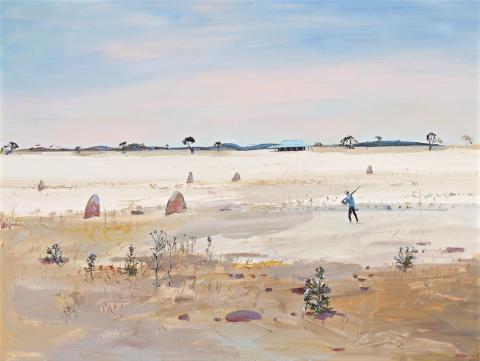WIMMERA LANDSCAPE WITH HUNTER, c.1985
ARTHUR BOYD
oil and tempera on composition board
90.0 x 120.0 cm
signed lower right: Arthur Boyd
bears inscription verso: 4
Wagner Art Gallery, Sydney (label attached verso)
Private collection, Sydney
Arthur Boyd: A Collection of Important Paintings, Wagner Art Gallery, Sydney, 22 September – 11 October 1987, cat. 4 (as ‘Man with Gun – Wimmera Landscape’)
From as early as the 1940s, Arthur Boyd stopped dating his canvases. This was not some deliberate obscuration aimed at historians or the art market; rather, it was Boyd’s understanding that his was an unfolding vision, one where memories were revisited and often from afar. As his technique altered over time, he would go back to previous themes with new-found technical possibilities, and Wimmera Landscape with Hunter, c.1985 is one such example. It is a re-imagining of the Wimmera region in north-west Victoria, a landscape now marked by endless fields of wheat interspersed with the debris and scars left over from the gold rushes of the nineteenth century. Given its dating, the painting was most likely executed overseas in one of Boyd’s home-studios in England or Italy where ‘(i)n a snow-bound studio he … envisioned the desert: in a garden of ash and maple trees, he … painted gum and wattle’.1
Boyd first visited the arid location in the summer of 1948 – 49, painting at the border of the Wimmera River. Over the next few years, he also visited the old mining sites near Mt William and around Bendigo. Boyd was struck by the Wimmera’s luminous sky and was also drawn to the visible scars of human presence left in the land, in particular the residue from the 1850s gold rush, still visible a century later. ‘Diggers and gold escorts from South Australia made their way through the Wimmera (and) many Chinese came this way to evade the entry tax imposed on all Chinese at Victorian ports … By the 1870s the Wimmera was swarming with selectors, many of them ex-miners. The golden age of wheat had commenced and would continue long after the gold had run out in other areas.2 One such souvenir still dotted through this former mining landscape is the compacted piles of rock and dirt known as mulloch heaps, left over from miners digging for gold. Boyd painted these mounds and scattered boulders earlier in Old Mining Country Near Bendigo, 1951, and Mining Country, c.1952, then over time, morphed them into pronounced anthill-like formations. Such nests are not actually a feature of the Wimmera though this has led to some related versions being mis-identified with titles such as Landscape with Anthills, n.d., and Anthills and Cockatoos in the Wimmera, c.1986. As ever, Boyd includes a human or animal presence in the otherwise sparse scene, such as the hunter and homestead featured here, thus providing his Wimmera paintings with ‘a sense of acceptance that many country dwelling Australians could identify with readily’.3
By the end of his long life, Arthur Boyd had become one of Australia’s most revered and best-loved artists whose highly personalised, expressive paintings of his homeland became iconic statements within this country’s art history. Even though he spent many years painting in Europe, he always maintained a vivid connection to his birthplace and particularly the Wimmera, remaining ‘nostalgic for (the feeling of) prickly grass’.4
1. McGrath, S., ‘Boyd still the master’, The Australian, Sydney, 12 March 1980
2. See: ‘Land of Gold – Victoria’s Western Region’, E-Gold: a Nation’s heritage: Electronic Encyclopedia of Gold in Australia, The University of Melbourne, Melbourne, accessed online 20 October 2017 [http://www.egold.net.au/biogs/EG00297b.htm]
3. McKenzie, J., Arthur Boyd: art and life, Thames and Hudson, London, 2000, p. 91
4. Boyd, A., quoted in Niall, B., The Boyds, Melbourne University Press, Victoria, 2007 (2002), p. 336
ANDREW GAYNOR
